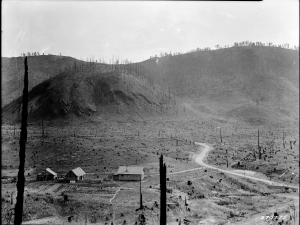 “The question of forest fires, like the question of slavery … sooner or later, it must be faced.” So said Gifford Pinchot, the zealous conservationist who founded the U.S. Forest Service in 1905.
“The question of forest fires, like the question of slavery … sooner or later, it must be faced.” So said Gifford Pinchot, the zealous conservationist who founded the U.S. Forest Service in 1905.
The back story and legacy of the U.S. Forest Service as it secured its footing and grappled with the fury and capriciousness of Mother Nature during the early 20th century makes for a surprisingly riveting hour in The Big Burn. Written and directed by Emmy Award-winner Stephen Ives, The Big Burn premieres tonight on American Experience (Tuesday, February 3, 2015, 9:00 – 10:00 p.m. ET on PBS. Check local listings for air times in your region). The film will also be available on DVD and for online streaming at http://www.pbs.org/wgbh/americanexperience/
The idealism that compelled men like Gifford Pinchot to protect and conserve the American wilderness in the early 1900s, while courageous and important to the survival of our planet, was also fraught with the tunnel vision and hubris that idealism tends to engender. Wealthy eccentric Pinchot was a close ally of Teddy Roosevelt and shared Roosevelt’s passion for conservation, including the scientific management of forests, controlled logging in national forests and controlled grazing rights for farmers and ranchers. Pinchot and Roosevelt’s drive to protect America’s pristine forest land before it was decimated by the logging and mining industries, ranches and farmlands, and the detritus of encroaching towns, railroads and factories challenged the ranks of the initial Forest Service recruits.
Fresh out of Yale’s Forestry School, these young men ambled into the national forests with promise and purpose but little else. It soon became clear that they were ill-equipped to deal with the roustabouts and bawdy denizens of the shanty towns popping up in Montana, Idaho and South Dakota or for the unpredictability of Mother Nature.
Too limited in number to handle the massive lands under their jurisdiction, they were, as a result, unable to manage and control the fires that spread during the drought that fried the Northern Rockies in 1908 and 1909. By the summer of 1910, when many of these fires melded into one, the firefighters soon faced the challenge of a lifetime–a fire that came to be known as “the Big Burn.”

What remained of a fire-ravaged valley. Photo courtesy National Archives and Records Administration.
“Firefighting was a very primitive science. They were learning as they went along,” says Timothy Egan, the author of the best-selling book, The Big Burn: Teddy Roosevelt and the Fire that Saved America, on which the film is based. This horrifying conflagration devoured more than three million acres across the Northern Rockies, a catastrophe that impacted the agency and the nation’s fire containment policy going forward. The “Big Burn” and the limitations of firefighting techniques that led to its spread (its physical residue stretched as far as Boston and Greenland) brought with it death, disfigurement and destruction, much heroism and a steep learning curve.
The fire’s back story is ably told here by author Egan and fellow historians, fascinating archival period footage and photos, and engaging voice over narration by actor Oliver Platt. Filmmaker Stephen Ives’ long collaboration with Ken Burns shows in the cadence of Platt’s delivery, which seems plucked whole cloth from one of Burns’ films.

Seven companies of Buffalo Soldiers, the first African-Americans to serve as peacetime soldiers, heroically tackled and helped contain the Big Burn. Photo courtesy The Museum of North Idaho.
American Experience: The Big Burn is an enlightening and cautionary look at the legacy of early conservationists like Pinchot and Roosevelt, the clear thinking heroics exhibited by the Buffalo Soldiers and frontiersmen like Ed Pulaski, and the problematic philosophy driving firefighting in the American frontier. The long-term effects of the fire containment policies resulting from this historic fire should prove to be quite an eye-opener for those Americans continuing to face seasonal drought and wildfires.
A timely broadcast celebrating the 110th anniversary of the U.S. Forest Service, American Experience–The Big Burn premieres tonight, Tuesday, February 3, 2015, on PBS (9:00 p.m. – 10:00 p.m. ET). Check local listings for premiere and repeat broadcasts in your region. The film will be available on DVD and for online streaming at http://www.pbs.org/wgbh/americanexperience/ –Judith Trojan



The Gordon Pinchot quote at the head of your post is rather provocative. What connection can there be between forest fires and “the question of slavery”? Of course, I haven’t yet seen this program, so this point may be addressed, but out of context it seems like a weird, possibly offensive, statement to make.
LikeLike
The complete quote is even more problematic in that regard; but he was a product of his time and class, and he was driven to keep the Forest Service afloat and conserve America’s public lands. The quote, which is prominent in the film’s promotional materials, clearly underscores his zeal and the importance of that mission. If you watch the film, you may not agree with his analogy, but you’ll hopefully understand his passion.
LikeLiked by 1 person